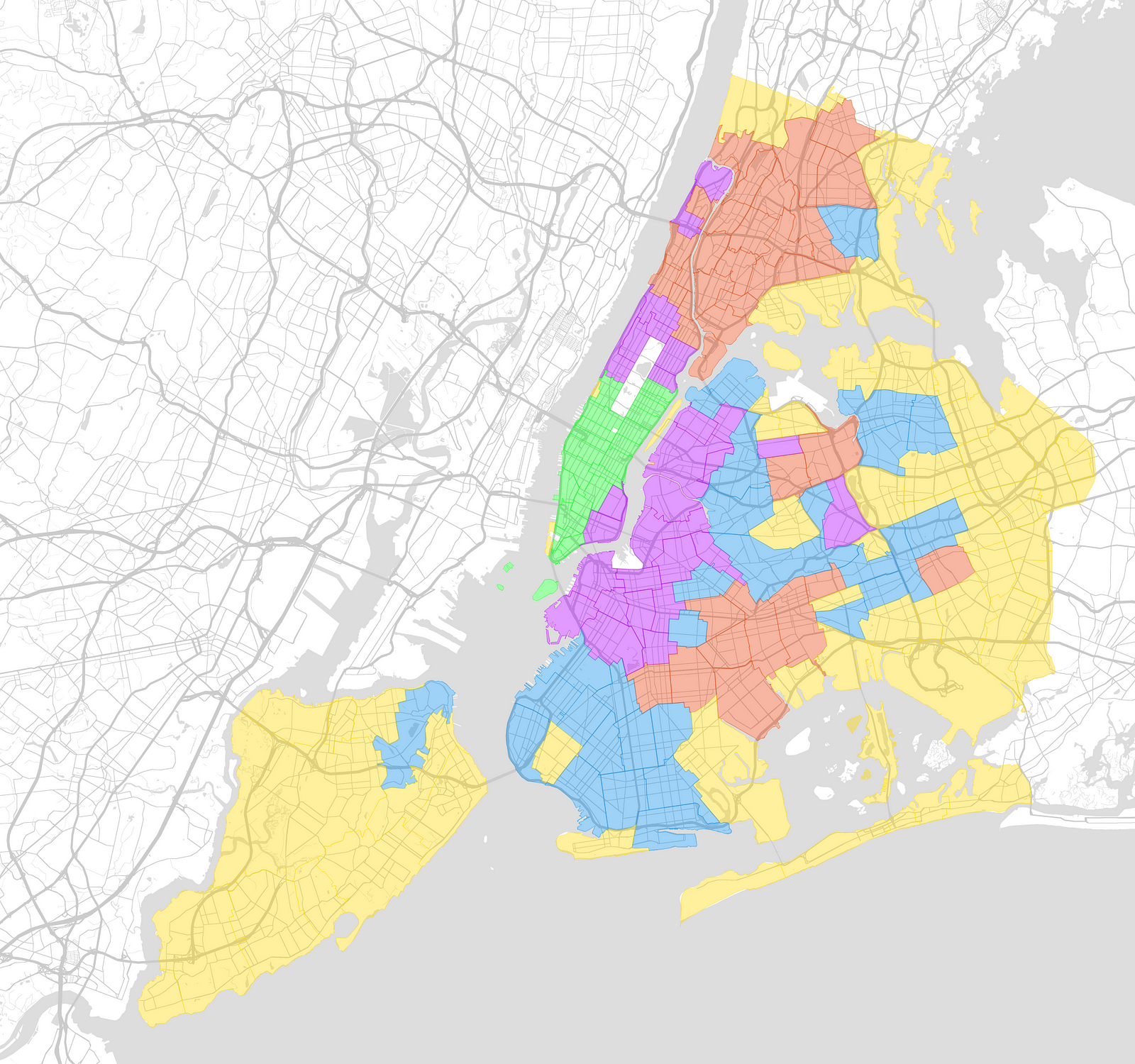We all hear about "Brooklyn the brand," or casual references to "Brooklyn" in popular culture. Remember, marketing for 550 Vanderbilt claims "Everything you love about Brooklyn."
But that "Brooklyn" is only a piece of the larger borough.
A new effort to reframe how we think about the borough--all the boroughs--comes from the urban-focused artificial intelligence studio Topos, in this Medium post (and described in FastCoDesign):
But that "Brooklyn" is only a piece of the larger borough.
A new effort to reframe how we think about the borough--all the boroughs--comes from the urban-focused artificial intelligence studio Topos, in this Medium post (and described in FastCoDesign):
With the exception of Queens/Brooklyn, all boroughs are separated from one another by water. The implications and limitations of this physical partitioning of land have changed considerably since the initial formation of the boroughs. New York City is now connected by over 2000 bridges and tunnels, the vast majority of which were built after 1898.So they come up with:
...Furthermore, we were interested in going beyond more familiar demographic viewpoints to capture the personality of a place, and what it feels like to actually be there. In a sense, we’ve developed a ‘psychographics’ of neighborhoods. As part of this endeavor, we have constructed a suite of features and indices about neighborhoods and cities that encompasses everything from topological analysis of urban form, to ambient light levels, to the prevalence of craft cocktails within a neighborhood.
1. Green cluster — ‘Minhattan’So that means four Brooklyns, at least. The process is inexact: somehow suburban Sea Gate, at the far west end of Coney Island, is lumped in with adjacent housing projects and classified as "The Meadows." And there's no room (yet) to map poverty, ethnicity, and language.
Heavily built up, Vertical borough, Highest establishment density
2. Purple cluster — ‘The Ring’
Expensive, Commuter-oriented
3. & 4. Red and Blue Clusters—‘North Bend’ and ‘South Bend’
Largely residential, Less commercial density
5.Yellow Cluster—‘The Meadows’
Leafy, Suburban, Spread out
But it's a another contribution to correcting knee-jerk assessments of Brooklyn.
"The Four Brooklyns"
This effort reminded me of a song: in December 2008, during the workshop production of Brooklyn at Eye Level, which later became the more Atlantic Yards-focused In the Footprint, the composer Michael Friedman performed "The Four Brooklyns."
Socioeconomically, Friedman speak-sings, there are four Brooklyn: Manhattan (from Greenpoint to Red Hook, more affluent, development trends from ), The Caribbean (West Indian neighborhoods like Flatbush and Canarsie), The Mediterranean (Bushwick, Bay Ridge, Bensonhurst, Sunset Park, etc.), Florida (predominantly white, many of them Jews and Russians).
As I wrote in my 2011 review, I found the song clever but frustrating. After all, where were Chinese Sunset Park or Bedford-Stuyvesant, the largest African-American neighborhood in Brooklyn?
But the song, based on an admittedly broad sociological analysis by former City Council Member, unsuccessful Borough President candidate, and attorney Ken Fisher, deserves credit for getting us past the monolithic and misleading notion of "Brooklyn." So does the map. Let the efforts continue.
 |
| From Topos |
This effort reminded me of a song: in December 2008, during the workshop production of Brooklyn at Eye Level, which later became the more Atlantic Yards-focused In the Footprint, the composer Michael Friedman performed "The Four Brooklyns."
Socioeconomically, Friedman speak-sings, there are four Brooklyn: Manhattan (from Greenpoint to Red Hook, more affluent, development trends from ), The Caribbean (West Indian neighborhoods like Flatbush and Canarsie), The Mediterranean (Bushwick, Bay Ridge, Bensonhurst, Sunset Park, etc.), Florida (predominantly white, many of them Jews and Russians).
As I wrote in my 2011 review, I found the song clever but frustrating. After all, where were Chinese Sunset Park or Bedford-Stuyvesant, the largest African-American neighborhood in Brooklyn?
But the song, based on an admittedly broad sociological analysis by former City Council Member, unsuccessful Borough President candidate, and attorney Ken Fisher, deserves credit for getting us past the monolithic and misleading notion of "Brooklyn." So does the map. Let the efforts continue.
Comments
Post a Comment